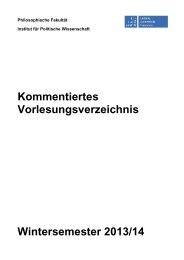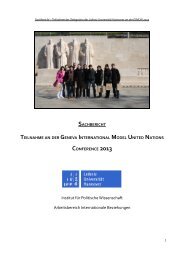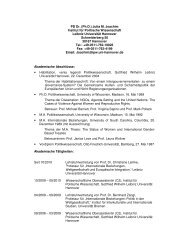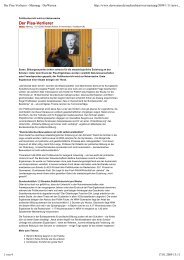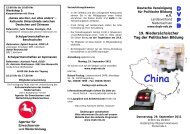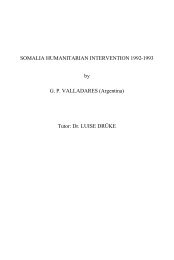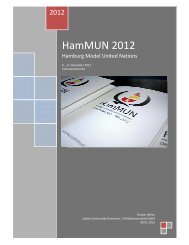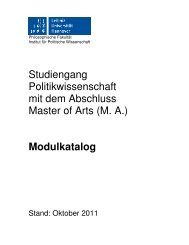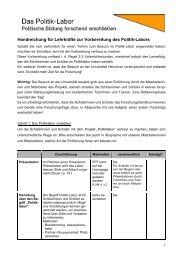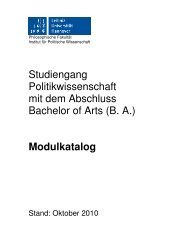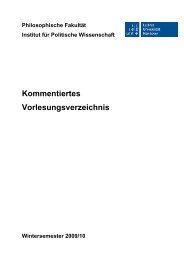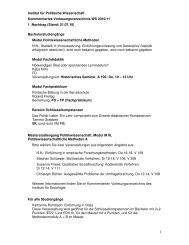Preventive Action for Refugee Producing Situations
Preventive Action for Refugee Producing Situations
Preventive Action for Refugee Producing Situations
You also want an ePaper? Increase the reach of your titles
YUMPU automatically turns print PDFs into web optimized ePapers that Google loves.
86 Chapter 3<br />
Principal pull factors are:<br />
1. Resettlement in the West<br />
2. No right of return to Vietnam<br />
3. No screening and no voluntary repatriation<br />
4. Hope <strong>for</strong> rescue at sea by international vessels<br />
5. United Nations aid in camps in neighboring countries<br />
6. Overseas Vietnamese lobby <strong>for</strong> aid and resettlement<br />
a) Push factors<br />
Push factors are problems that may eventually compel people to leave the<br />
country. 178 In the recent history of Vietnam, we have identified the following<br />
as the most important push factors.<br />
1. Family reunification<br />
In Asian cultures, where extended families are common, the integrity of the<br />
family unit is crucial. For UNHCR, the reunification of refugees with their<br />
families is a generally accepted principle; family members, especially<br />
spouses and dependents, are entitled to be reunited with their relatives<br />
living as refugees outside the country of origin. During the years be<strong>for</strong>e the<br />
ODP was set up, UNHCR operated a limited family reunion program. 17 9<br />
The more Vietnamese who escaped, however, the greater the number of<br />
people staying behind in Vietnam who also wanted to leave.<br />
Although on 26 February 1988 the Chairman of the Council of Ministers<br />
issued a decision authorizing Vietnamese citizens to leave the<br />
_______________________<br />
178 Clark, "Early Warning of <strong>Refugee</strong> Flows," (Draft) <strong>Refugee</strong> Policy Group,<br />
Washington, June 1988, p. 9.<br />
179 The Executive Committee of the UN High Commissioner's Programme<br />
adopted specific Conclusions on this subject. The first is No. 9 (XXVIII) of<br />
1977: "The Executive Committee<br />
(a) Reiterated the fundamental importance of the principle of family reunion;<br />
(b) Reaffirmed the co-ordinating role of UNHCR with a view to promoting<br />
the reunion of separated refugee families through appropriate interventions<br />
with Governments and with intergovernmental organizations;<br />
(c) Noted with satisfaction that some measures of progress has been achieved<br />
in regard tothe reunion of separated families through the ef<strong>for</strong>ts currently<br />
undertaken by UNHCR." A second Conclusion (No. 24 (XXXII)) of 1981<br />
elaborates the previous one. Among others, Para. 4 this Conclusion<br />
recognizes the right of everyone to leave any country, including his own to<br />
join the refugee abroad.<br />
Analytical Discussion 87<br />
country <strong>for</strong> a specified period of time to settle personal affairs, this is not likely<br />
to reduce the stream of people wishing the to join their family members abroad.<br />
Besides, few if any countries are likely to provide visitor visas, suspecting the<br />
applicants (probably correctly) of using this avenue as a way to enter their<br />
country permanently. 180<br />
2. Racial discrimination<br />
Of a population of three million living in the South Vietnamese capital after<br />
1975, there were more than one million ethnic Chinese living in the Cholon<br />
section of the capital. Many of the ethnic Chinese had become Vietnamese<br />
citizens as a means of avoiding legalized discrimination against their commercial<br />
activities. Their communities were like a state within a state, never really a part<br />
of the Vietnamese community. The estimated ethnic Chinese population of North<br />
Vietnam was 300,000, of whom some 250,000 crossed into China during 1978<br />
and 1979.<br />
The sudden change from the artificial wartime prosperity in Saigon, with a<br />
growing urban population depending on American financial backing to survive,<br />
was most sharply felt by the large ethnic Chinese community. Its members had<br />
dominated commerce of all kinds throughout the colonial and postcolonial<br />
periods. 181 In the spring of 1978 governmental troops confiscated gold, jewelry,<br />
rice, and vegetables -much of the property of the Chinese Vietnamese in Cholon<br />
- and sent some 700,000 of them to New Economic Zones. This prompted them<br />
to leave in large groups, a practice the government unofficially tolerated and<br />
even encouraged, as became clear in negotiations <strong>for</strong> the definition of persons to<br />
182<br />
qualify <strong>for</strong> the Orderly Departure Program. Whereas UNHCR and<br />
resettlement countries wanted the ODP <strong>for</strong> family reunion cases, the Vietnamese<br />
authorities insisted on broadening the categories to<br />
180 "Government Issues Decision on Foreign Travel," BK291544 Hanoi Domestic<br />
Service in Vietnamese, FBIS- EAS- 88-040,1 March 1988.<br />
181 See Osborne, pp. 39-40.<br />
182 Depending on the place of departure (Vungtau or the Mekong Delta), the price <strong>for</strong><br />
flight to an uncertain point of arrival has been some US $2,000 when the "big boat<br />
trade" in ethnic Chinese refugees started in 1978. Seven years later, the cost to<br />
leave by boat was still between 540,000 and 630,000 Dong in gold (equivalent to<br />
US $1,500-2,000). See Jürgen Dauth, "Aus der täglichen Not in eine Ungewisse<br />
Zukunft, In Südostasien droht eine neue Fluchtwelle der Vietnamesen über das<br />
Sudchinesische Meer", quoted in Fluchtmotive: Vietnam, Äthiopien, Sri Lanka,<br />
ZDWF Schriftenreihe No. 23, (Bonn: Zentrale Dokumentationsstelle für Flüchtlinge<br />
der Freien Wohlfahrt, 1987), pp. 30-38.



